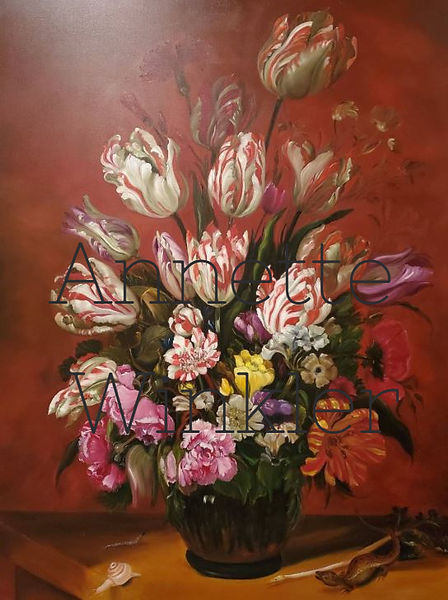Copying the work of the old master whose work I admire is an highly instructive practice.
TULIP FEVER
#TulipFever
SOLD
The original Floral Still Life was painted by Hans Boulenger in 1639.
It is displayed at the Rijks Museum.
This exuberant bouquet may look natural, but tulips, anemones, roses and carnations do not all bloom at the same time. Boulenger nevertheless managed to assemble a balanced composition. The still life was painted shortly after the Dutch stock market crashed in 1637, when many people went bankrupt due to the speculation in tulip bulbs.
In Haarlem, the artist’s hometown, a bulb of this variety was purchased for 6,000 guilders approximately 21 kg of gold). This festive bouquet may thus refer to the transience of earthly matters.
Lizard and caterpillar are symbols of decay snail stands for lust.
A lush bouquet of flowers stands on the table. The glass vase is barely big enough to hold the profusion of tulips, roses, anemones, and carnations. The painter knew how to turn a bouquet of flowers into a unified whole. He achieved this effect by means of a more supple technique, by using less diverse and less exuberant colors, by letting some of the flowers to overlap and by the subtle play of light and shadow. Part of this red and white bouquet remains in the shadow, while several flamed tulips catch the full light.

THE WRECK OF HOPE
#WreckOfHope
SOLD
The painting in the picture is of Casper David Friedrich, The Sea of Ice (1823-24), located at the Kunsthalle Hamburg.
My copy is painted in oil, signed on the back "Annette Winkler after Caper David Friedrich".
The Sea of Ice (German: "Das Eismeer), is an oil painting of 1823–1824 by the German Romantic artist "Caspar David Friedrich"
The landscape depicts a shipwreck in the middle of a broken ice-sheet, whose shards have piled up after the impact. The ice has become like a monolithic tomb, whose edges jut into the sky.
The stern of the wreck is just visible on the right. As an inscription on it confirms, this is "HMS Griper (1813)"
Caspar David Friedrich was a 19th-century German Romantic landscape painter, generally considered the most important German artist of his generation.

